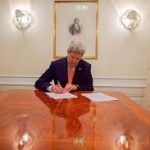How the United States benefits if Iran’s economy booms
By Ariane Tabatabai, Minsu Crowder-Han | February 19, 2016
When Iranians get ahead of themselves, they remind each other that it’s not over “until the donkey has crossed the bridge.” Since the United States lifted sanctions on Iran in January, part of its commitment under the historic nuclear agreement concluded last year, there has been great temptation to believe that the donkey has made it to the other side. Some 80 million Iranians have high hopes that economic relief is nigh. In fact, though, the lifting of sanctions only marked the beginning of the crossing.
The central promise of the nuclear agreement—the Joint Comprehensive Plan of Action, or JCPOA—was that in return for scaling back its nuclear program, Iran would receive sorely-needed economic relief from the United States and its five negotiating partners. Like any agreement, long-term effectiveness will hinge on both sides getting what they want. But right now, there is a lot standing between the Iranian people and what they want, including members of both countries’ political establishments. In Iran, some candidates running for seats in the February 26 parliamentary elections are quick to criticize President Hassan Rouhani for making nuclear concessions, while in Washington, politicians threaten to undo the JCPOA or impose new sanctions.
Allowing Iranian hopes to be dashed, though, would not only threaten the success of the nuclear deal, but also the long-term effectiveness of sanctions as a foreign policy tool. Delivering economic relief will be a difficult task, given the myriad challenges outside US control that hamstring Iran’s economy, but Washington has a vital role to play by laying the groundwork for Tehran’s reintegration into the global financial system—through adjusting its attitude from one of obstruction to cooperation.
Iranian hopes and hurdles. Rouhani’s government is especially eager to see the Iranian economy normalize, as his ability to be re-elected to a second and final term in 2017 depends on it. His government has taken a number of steps to limit the country’s nuclear program since the JCPOA was reached last summer. With sanctions now lifted, the Iranian people and Rouhani—elected with the mandate to normalize Tehran’s political and economic status in the world—anticipate re-entry into the global economy. But the government knows full well that both the viability of the deal and its own legitimacy rest not on the lifting of sanctions per se, but on the economic relief that is supposed to follow.
Unfortunately there are hurdles between the former and the latter. Some are homegrown and include systemic weaknesses in the Iranian economy, such as corruption, mismanagement, lack of diversification, and the penetration of the Revolutionary Guards into key sectors of the country’s economy. Iran has sought to remedy some of these problems through economic reforms. For instance, Rouhani cut funding to the Revolutionary Guards’ in the 2016-2017 budget he presented to parliament just after sanctions were lifted in January. His government aims to retake economic ground lost to “sanctions profiteers,” including the Guards. But the reforms will take a while to kick in.
Other obstacles are outside of Iran’s control. The “snap back” option built into the nuclear agreement, which allows the foreign powers to reimpose sanctions should Iran renege on its commitments, could discourage businesses from working in or with Iran by making the arduous process of setting up shop in a new country seem potentially futile. Add to this concerns about a future US president “undoing” the nuclear deal, and businesses have ample reason for reluctance. Companies are likely to be especially hesitant about long-term investments, like constructing factories, for the foreseeable future.
Compounding anxiety is the fact that the era of sanctions against Iran isn’t over. While nuclear-related sanctions have been lifted, the United States, and to a lesser extent the United Nations and European Union, continue to maintain sanctions that target Iranian sponsorship of terrorism, human rights abuses, and Tehran’s missile program. New sanctions targeting individuals and businesses that import certain missile-related materials were added in January.
The sanctions still in place not only prevent direct economic engagement between Iran and the United States, but will continue to stymie business between Iran and other countries. People and companies that do business with sanctioned Iranian entities still risk incurring the wrath of the US government in the form of so-called secondary sanctions. For example, if a European bank clears a transaction for a sanctioned Iranian company, it could face penalties such as asset freezes and prohibitions on accessing the US financial system. Remaining US sanctions also limit business opportunities in Iran to large conglomerates, usually those with some level of state backing, cutting out smaller, privately owned Iranian businesses. While the Persian market may be tempting, its allure is unlikely to outweigh a healthy fear of US sanctions or the cost of navigating a tricky regulatory landscape.
These issues are real impediments to the economic relief Iranians want, which in turn makes them threats to the long-term success of the nuclear deal and the effectiveness of sanctions writ large. If foreign businesses can’t enter or successfully navigate the Iranian market, lifted sanctions won’t matter much to the Iranian people. This will undermine Rouhani’s team, who made significant concessions on the premise that its efforts would be rewarded. If Iran gets no economic benefit from the JCPOA, this could not only erode the country’s commitment to the nuclear deal, but also its willingness to negotiate on other critical security issues, such as its support for Syria’s Assad regime or the fight against ISIS.
US leadership required. The implications go well beyond US policy towards Tehran. Whether the nuclear deal is felt as an economic success in Iran will also have an impact on the effectiveness of US foreign policy more generally. Sanctions are increasingly used as a tool to make uncooperative states change their ways, whether that means trying to stop nuclear proliferation, check aggression, or counter expansionist policies like Russia’s. Discussion tends to focus on applying sanctions, but easing and removing them are at least as important. The threat of sanctions may be a stick, but the prospect of lifting them is quite the carrot. That’s because once they are imposed, states learn to live with them, and the threat of their continuation becomes increasingly less intimidating. For a country living under sanctions, the prospect of their removal can induce a change in behavior. But if countries can see that lifting them won’t have the desired economic impact, they will become a much less effective tool.
Sanctions are an essential element of Washington’s Iran policy and are likely to remain a mainstay of the US foreign policy arsenal. But recent successes on the Iran front have led many to wrongly conclude that when it comes to sanctions, more is better. It’s this belief that underpins the recent effort by Congress to pass the Iran Terror Transparency Act. This bill would make it virtually impossible for some sanctions to be lifted as agreed under the JPCOA, by creating an impossible standard for the president to meet before removing certain financial institutions from sanctions lists. (Obama has said he will veto the legislation if it reaches his desk.)
Sanctions may be one of the sharpest tools in the US diplomatic arsenal, but they can be blunted through overuse or by rendering their removal meaningless. If US leaders want to ensure that they remain useful, then lifting them must deliver the windfall Iranians hope for. How can Washington help make sure that happens? Key government players, such as the US Treasury, Commerce, and State departments, should develop stronger ties with the private sector, which will help build trust that the foreign companies doing business in Iran won’t be unfairly punished or caught off guard. While Treasury has begun to issue guidance about what lifting sanctions means for businesses, other authorities still need to follow suit. They should also create avenues through which companies can seek clarification and receive information specific to their needs, as the sanctions provisions are extremely complex and hard to navigate. This will require a change in the mindset that has prevailed in Washington for over a decade. Attitudes, like donkeys, can be stubborn, but only with a new attitude can the United States see the donkey to the other side of the bridge.
Together, we make the world safer.
The Bulletin elevates expert voices above the noise. But as an independent nonprofit organization, our operations depend on the support of readers like you. Help us continue to deliver quality journalism that holds leaders accountable. Your support of our work at any level is important. In return, we promise our coverage will be understandable, influential, vigilant, solution-oriented, and fair-minded. Together we can make a difference.
Topics: Columnists, Nuclear Weapons















